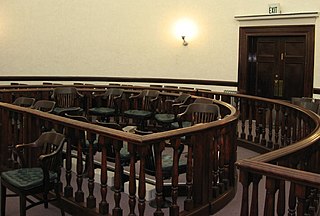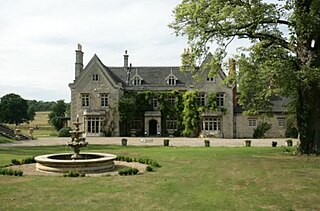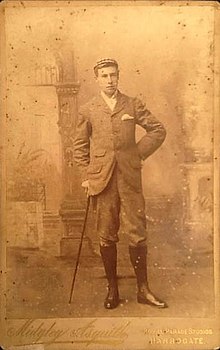
Defamation is a communication that injures a third party's reputation and causes a legally redressable injury. The precise legal definition of defamation varies from country to country. It is not necessarily restricted to making assertions that are falsifiable, and can extend to concepts that are more abstract than reputation – like dignity and honour. In the English-speaking world, the law of defamation traditionally distinguishes between libel and slander. It is treated as a civil wrong, as a criminal offence, or both.
McDonald's Corporation v Steel & Morris[1997] EWHC 366 (QB), known as "the McLibel case", was an English lawsuit for libel filed by McDonald's Corporation against environmental activists Helen Steel and David Morris over a factsheet critical of the company. Each of two hearings in English courts found some of the leaflet's contested claims to be libellous and others to be true.

A jury is a sworn body of people (jurors) convened to hear evidence, make findings of fact, and render an impartial verdict officially submitted to them by a court, or to set a penalty or judgment.

Madame Tussauds is a wax museum founded in London in 1835 by the French wax sculptor Marie Tussaud. One of the early main attractions was the Chamber of Horrors, which appeared in advertising in 1843.
Jury nullification (US/UK), jury equity (UK), or a perverse verdict (UK) occurs when the jury in a criminal trial gives a not guilty verdict regardless of whether they believe a defendant has broken the law. The jury's reasons may include the belief that the law itself is unjust, that the prosecutor has misapplied the law in the defendant's case, that the punishment for breaking the law is too harsh, or general frustrations with the criminal justice system. Some juries have also refused to convict due to their own prejudices in favor of the defendant. Such verdicts are possible because a jury has an absolute right to return any verdict it chooses.
New York Times Co. v. Sullivan, 376 U.S. 254 (1964), was a landmark U.S. Supreme Court decision ruling that the freedom of speech protections in the First Amendment to the U.S. Constitution restrict the ability of public officials to sue for defamation. The decision held that if a plaintiff in a defamation lawsuit is a public official or candidate for public office, then not only must they prove the normal elements of defamation—publication of a false defamatory statement to a third party—they must also prove that the statement was made with "actual malice", meaning the defendant either knew the statement was false or recklessly disregarded whether it might be false. New York Times Co. v. Sullivan is frequently ranked as one of the greatest Supreme Court decisions of the modern era.
Gertz v. Robert Welch, Inc., 418 U.S. 323 (1974), was a landmark decision of the US Supreme Court establishing the standard of First Amendment protection against defamation claims brought by private individuals. The Court held that, so long as they do not impose liability without fault, states are free to establish their own standards of liability for defamatory statements made about private individuals. However, the Court also ruled that if the state standard is lower than actual malice, the standard applying to public figures, then only actual damages may be awarded.
Not proven is a verdict available to a court of law in Scotland. Under Scots law, a criminal trial may end in one of three verdicts, one of conviction ("guilty") and two of acquittal.

Sir Bernard Henry Spilsbury was a British pathologist. His cases include Hawley Crippen, the Seddon case, the Major Armstrong poisoning, the "Brides in the Bath" murders by George Joseph Smith, the Crumbles murders, the Podmore case, the Sidney Harry Fox matricide, the Vera Page case, and the murder trials of Louis Voisin, Jean-Pierre Vaquier, Norman Thorne, Donald Merrett, Alfred Rouse, Elvira Barney, Toni Mancini, and Gordon Cummins. Spilsbury's courtroom appearances became legendary for his demeanour of effortless dominance.

Amanda Marie Knox is an American author, activist, and journalist. She spent almost four years incarcerated in Italy following her wrongful conviction for the 2007 murder of Meredith Kercher, a fellow exchange student with whom she shared an apartment in Perugia. In 2015, Knox was definitively acquitted by the Italian Supreme Court of Cassation.
Modern libel and slander laws in many countries are originally descended from English defamation law. The history of defamation law in England is somewhat obscure; civil actions for damages seem to have been relatively frequent as far back as the Statute of Gloucester in the reign of Edward I (1272–1307). The law of libel emerged during the reign of James I (1603–1625) under Attorney General Edward Coke who started a series of libel prosecutions. Scholars frequently attribute strict English defamation law to James I's outlawing of duelling. From that time, both the criminal and civil remedies have been found in full operation.

Caylee Marie Anthony was an American toddler who lived in Orlando, Florida, with her mother, Casey Marie Anthony, and her maternal grandparents, George and Cindy Anthony. On July 15, 2008, Caylee was reported missing in a 9-1-1 call made by Cindy, who said she had not seen the child for thirty-one days. According to what Cindy told police dispatchers, Casey had given varied explanations as to Caylee's whereabouts before eventually saying she had not seen her daughter for weeks. Casey later called police and falsely told a dispatcher that Caylee had been kidnapped by a nanny on June 9. Casey was charged with first-degree murder in October 2008 and pleaded not guilty.

David Irving v Penguin Books and Deborah Lipstadt is a case in English law against American historian Deborah Lipstadt and her British publisher Penguin Books, filed in the High Court of Justice by the British author David Irving in 1996, asserting that Lipstadt had libelled him in her 1993 book Denying the Holocaust. The court ruled that Irving's claim of libel relating to Holocaust denial was not valid under English defamation law because Lipstadt's claim that he had deliberately distorted evidence had been shown to be substantially true. English libel law puts the burden of proof on the defence, meaning that it was up to Lipstadt and her publisher to prove that her claims of Irving's deliberate misrepresentation of evidence to conform to his ideological viewpoints were substantially true.
Vicarious liability in English law is a doctrine of English tort law that imposes strict liability on employers for the wrongdoings of their employees. Generally, an employer will be held liable for any tort committed while an employee is conducting their duties. This liability has expanded in recent years following the decision in Lister v Hesley Hall Ltd to better cover intentional torts, such as sexual assault and deceit. Historically, it was held that most intentional wrongdoings were not in the course of ordinary employment, but recent case law suggests that where an action is closely connected with an employee's duties, an employer can be found vicariously liable. The leading case is now the Supreme Court decision in Catholic Child Welfare Society v Institute of the Brothers of the Christian Schools, which emphasised the concept of "enterprise risk".

Sir Henry Duncan Littlejohn MD LLD FRCSE was a Scottish surgeon, forensic scientist and public health official. He served for 46 years as Edinburgh's first Medical Officer of Health, during which time he brought about significant improvements in the living conditions and the health of the city's inhabitants. He also served as a police surgeon and medical adviser in Scottish criminal cases.
John Gray Wilson QC was a Scottish advocate, writer and Liberal Party politician.
Amanda Duffy, a 19-year-old Scottish student, was killed in grisly circumstances in 1992. The main suspect, Francis Auld, was tried for murder in the High Court of Justiciary in Glasgow and was acquitted when the jury returned a majority verdict of "not proven". A bid by prosecutors to try Auld for a second time on the basis of new evidence was rejected by the courts in 2016. Auld died of pancreatic cancer in July 2017, aged 45.

Pipewell Hall in Northamptonshire, England, is a building of historical significance and is Grade II listed on the English Heritage Register. It was built near the ruins of a Cistercian abbey in 1675. At this time it was owned by the Barons of Powis. The house was constructed from the stones of the abbey. The Hall was the home of many notable people over the next three centuries and is now a wedding venue.

Henry Thomas Blyth (1852–1898) was a British writer who also wrote under the pen-name Hal Meredith. Blyth was born in Greenwich, London. He wrote for many of Alfred Harmsworth's papers of the 1890s, and is mostly remembered for creating detective Sexton Blake.
John C. Depp, II v. Amber Laura Heard was a trial held in Fairfax County, Virginia, from April 11 to June 1, 2022, that ruled on allegations of defamation between formerly married American actors Johnny Depp and Amber Heard. Depp, as plaintiff, filed a complaint of defamation against defendant Heard claiming $50 million in damages; Heard filed counterclaims against Depp claiming $100 million in damages.










